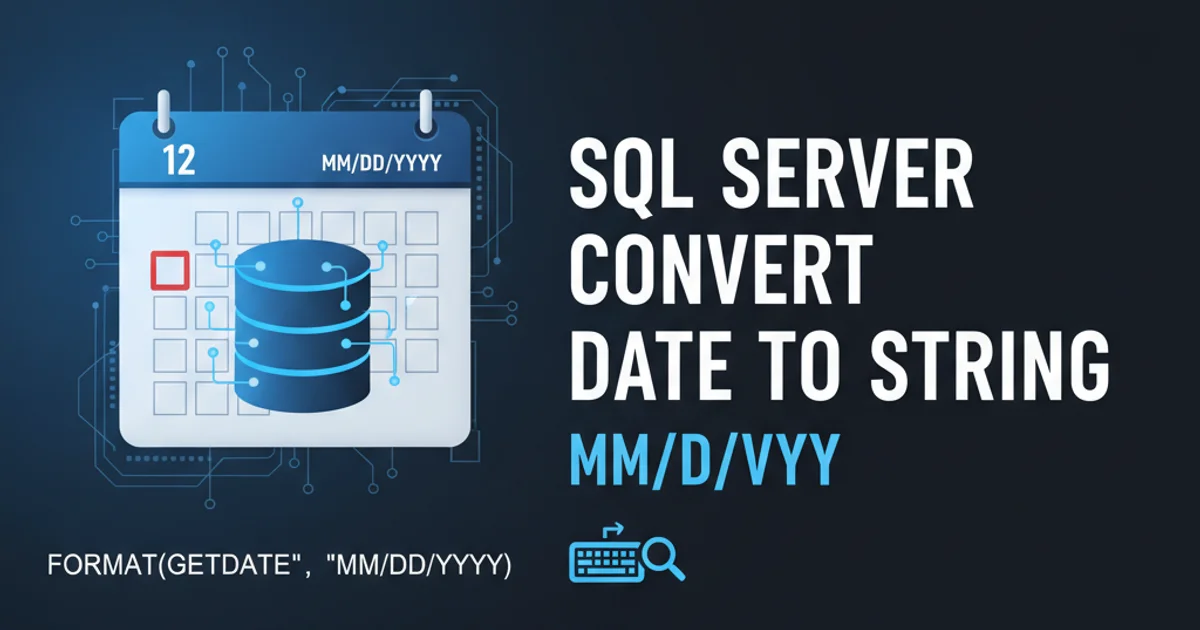sql server convert date to string MM/DD/YYYY
Categories:
Converting Dates to MM/DD/YYYY String Format in SQL Server

Learn various methods to format dates into the MM/DD/YYYY string format in SQL Server, including using CONVERT, FORMAT, and string manipulation, with considerations for different SQL Server versions.
Formatting dates into specific string representations is a common requirement in SQL Server, especially when preparing data for reports, user interfaces, or integrations with other systems. The MM/DD/YYYY format is widely used in the United States and often requested. This article explores several robust methods to achieve this conversion, catering to different SQL Server versions and performance needs.
Using the CONVERT Function
The CONVERT function is a versatile tool in SQL Server for type casting, including date to string conversions. It supports various style codes that dictate the output format. For MM/DD/YYYY, style code 101 is the most direct option. This method is available across all modern SQL Server versions, including SQL Server 2008 R2 and later.
SELECT CONVERT(VARCHAR(10), GETDATE(), 101) AS FormattedDate;
Converting current date to MM/DD/YYYY using CONVERT style 101.
VARCHAR when using CONVERT to avoid truncation or unnecessary padding. For MM/DD/YYYY, VARCHAR(10) is sufficient.Using the FORMAT Function (SQL Server 2012+)
For SQL Server 2012 and newer versions, the FORMAT function provides a more flexible and often more readable way to format dates and numbers. It leverages .NET Framework formatting rules, allowing for custom format strings. While powerful, it can be less performant than CONVERT for very large datasets due to its reliance on the CLR.
SELECT FORMAT(GETDATE(), 'MM/dd/yyyy') AS FormattedDate;
Formatting current date to MM/DD/YYYY using the FORMAT function.
FORMAT string: MM for month, dd for day, and yyyy for year. Using mm would represent minutes, and DD is not a valid date part.Manual String Concatenation (Older Versions or Custom Needs)
In scenarios where FORMAT is not available (e.g., SQL Server 2008 R2) and CONVERT styles don't perfectly match a complex custom format, or if you need to handle NULL dates explicitly, manual string concatenation can be used. This involves extracting date parts and assembling them. This method offers maximum control but can be verbose.
SELECT
RIGHT('0' + CAST(MONTH(GETDATE()) AS VARCHAR(2)), 2) + '/' +
RIGHT('0' + CAST(DAY(GETDATE()) AS VARCHAR(2)), 2) + '/' +
CAST(YEAR(GETDATE()) AS VARCHAR(4)) AS FormattedDate;
Manual date formatting using string concatenation for MM/DD/YYYY.
flowchart TD
A[Start with DATE/DATETIME] --> B{SQL Server Version?}
B -- "SQL Server 2012+" --> C[Use FORMAT Function]
C --> D["FORMAT(DateColumn, 'MM/dd/yyyy')"]
B -- "SQL Server 2008 R2+" --> E[Use CONVERT Function]
E --> F["CONVERT(VARCHAR(10), DateColumn, 101)"]
B -- "Custom/Fallback" --> G[Manual String Concatenation]
G --> H["RIGHT('0'+MONTH) + '/' + RIGHT('0'+DAY) + '/' + YEAR"]
D --> I[Result: MM/DD/YYYY String]
F --> I
H --> IDecision flow for choosing a date to string conversion method.